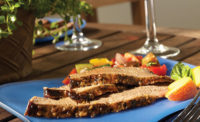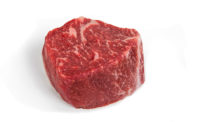Get Real with Beef
A cured beef cut: that’s Italian

It is said that bresaola originated in the Valtellina, where it was made from lean beef likely cut from the round.
Being of Italian heritage, I grew up a big fan of cured meats. One of my favorites of the dry cured variety was the prosciutto (pro-SHU-toh). Made for centuries by master meat craftsmen in the Parma region of Italy, the prosciutto was made simply by salting a fresh pork leg and then slow drying until it reached the perfect balance of taste, color and firmness. Etymologically, the term prosciutto comes from the Italian prosciugare (PRO-SHU-ga-ray) meaning “to dry thoroughly.” I’ve made a few traditional-style prosciutto hams during my adventures as a meat scientist and have had relatively good success; however, my day job requires a focus entirely on beef that led to discovering a lesser-known, but just as delicious, dry-cured whole-muscle cut made from beef that rivals my beloved prosciutto: bresaola (breh-ZO-la).
It is said that bresaola originated in the Valtellina, a long narrow valley in the Lombardo region of northern Italy, where it was made from lean beef likely cut from the round. I’ve found the eye of round to be an excellent candidate for making bresaola because of its shape, inherently lean nature, availability and affordability. The cut takes on a really great flavor when combined with the minimal ingredients used to make the bresaola.
The process of creating this simple, delicate, yet highly desirable treat is rather easy. Start with the beef eye of round and trim all heavy connective tissue and fat on the outside. Then I like to use just the bare minimum: salt, curing salt #2 (sodium nitrite, sodium nitrate), coarse ground black pepper and crushed, dried juniper berries. First, weigh out the entire amount of meat, and using a formula we created, measure the remaining non-meat ingredients the same way one would measure out a sausage formulation to equal 100 percent.
We gravitate toward kosher salt for its rather pure form of sodium chloride as well as the larger particle size that tends to stick nicely to the meat once applied. The curing salt of the #2 variety is common in long-term dry curing products as it contains not only sodium nitrite but also sodium nitrate. Sodium nitrate over time will convert to sodium nitrite, which is responsible for the pink coloring of cured products and helps control unsafe bacteria should they be present. The pepper gives a nice balanced flavor to the saltiness of the meat and contains some aromatic properties.
The dried juniper berries bring a distinct and unique flavor to the bresaola: slightly piney, fruity and peppery. Juniper berries can taste almost astringent when used in too large of a quantity, but when combined in a small dose, they can add a depth of flavor that is quite desirable, which is why it is often used to make traditional bresaola. These berries also contain very powerful antioxidants that help maintain the freshness and color of the bresaola through the long drying process.
Once the dry ingredients are mixed together they are vigorously massaged over the meat and subsequently allowed to remain on the meat for about 14 days. After the salting process, adhering dry ingredients are rinsed off and the meat is patted dry and prepared for the extended drying process. Our team prefers to stuff the eye of round into beef bung (appendix/cecum) but varietals of bresaola have been wrapped in cheesecloth instead, or even left uncased. I prefer to encase the meat to produce a cleaner finished product.
Prior to beginning the drying process I like to inoculate the outside of the encased product with a commercially available white mold known as Penicillium nalgiovense, which will not only produce the classic white appearance on the outside of the meat, but also help enhance the depth of flavor of the final product. Finally, the meat is hung for four to six months, until it has lost a minimum of 30 percent of its original weight when entering the drying process, and reaches a firm, dense feel on the outside. Traditionally, bresaola, as well as many old-world salamis, are dried at about 60 degrees F; however, I have found that drying at an even colder temperature (38 degrees F) can be quite effective while adding to overall food safety. I have also found that gentle air movement, not too much or too little, makes for a very consistent and evenly dried product.
When the bresaola is ready to be enjoyed, it needs to be sliced super-thin to truly appreciate its delicate flavor and texture. The slices should be silky smooth and almost see-through. Bresaola can be enjoyed by itself or with a number of accoutrements — I’ve found a citrus flavor or white wine pairs well, but it’s the taster’s job to find best fits.
Beef has played second fiddle to the noble hog when it comes to salumi/charcuterie. But I can visualize advancement in the curing art using beef as a raw ingredient. A depth of flavor is achieved with beef that cannot be found in the milder-flavored species. I highly recommend exploring new cuisines and preparations, and the dry-cured bresaola is an excellent entry into old-world gastronomy.
Buon appetito! NP
Editor’s Note: “Get Real with Beef” is a new column, written by Dr. Phil Bass, corporate meat scientist for the Certified Angus Beef® brand, and Editorial Board Member of The National Provisioner. Watch for his insights, including his take on beef cuts that processors should investigate adding to their product mix (Utilize This!), on a quarterly basis, exclusively in The National Provisioner.
Looking for a reprint of this article?
From high-res PDFs to custom plaques, order your copy today!






